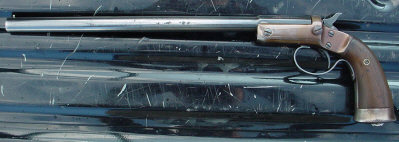
Stevens
Auto-shot / Off-hand shotgun
|
I have been inspired by recent researches into the Stevens Off -Hand
Shotgun or Auto-Shot, the Marble's Game Getter, and other small pocket
shotguns. Most of these guns chambered either the two inch .410 shotgun
shell or one of several brass .44 caliber cases filled with tiny shot
charges. I had grown quite curious about how effective a small pistol
might be when using only ¼ oz. Or 5/16 oz. Since there are no Stevens
Off Hand Shotguns nor Auto Shots to be borrowed in the US, and the two
inch .410 shell disappeared from US stores before WWII or earlier, I decided
to try some of the CCI shot shells in a variety of modern handguns. I
had on hand some old boxes in three loads which would compare favorably
with the old Game getter cartridges.
The shells I had included the .38/.357, the . 44 Magnum,
and the .45 ACP. I bought these years ago for some forgotten purpose and
they were gathering dust.
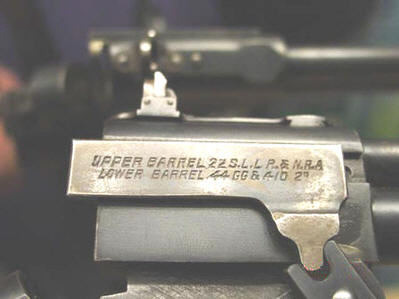
Marbles Game-Getter showing allowable cartridges
|
The .38/.357:
I first tried a couple of CCI shotshells in .38/.357.
I seem to have three varieties of these cartridges acquired different
times and places. The oldest were made, not by CCI, but by Speer. I think
these date back to the 70s. Now both CCI and Speer are part of a big industrial
group, but Speer actually developed the neat little capsules before the
companies merged. The old Speer box held only six cartridges while the
newer CCI packages contain ten rounds. The ancient Speer capsule is yellow,
the nickel-plated cases are head stamped "Speer." I recall that empty
capsules once were sold separately as reloading components. The reloader
filled them with his own shot before loading them into standard .38/.357
cases. I have not seen them in many years.
My second box is about ten years old and marked CCI, but
the cases are identical to those in the Speer box, including the Speer
head stamp, but the capsule is blue. Somewhere along the way, I acquired
a single Blazer-type aluminum cased round head stamped "CCI" but with
the same blue shot capsule. As nearly as I can tell, all three work equally
well.
The CCI plastic .38/.357 box says "1/4 oz. #9 shot (approx.
135 pellets)." (The old Speer says nothing.) Since I had more of the nickel
case CCI version and only one of each of the others, I did all my testing
with those cartridges. First, I disassembled one with an impact bullet
puller. The capsule broke and I was unable to remove the base of the capsule.
I found the shot charge to weigh 94 grains, or .21 ounce. The pellet count
was 112 which corresponds to 521 pellets to the ounce. These are on a
little the heavy side for 9s, which should average 585 to the ounce, but
within industry standards. Since I broke the capsule in disassembling
and could not remove some parts, I was unable to weigh either the capsule
or the powder charge.
For patterning, I used some cardboard I had cut from
big boxes to make pistol target backers. The cardboards measured about
27 inches by 36 inches. My first shot was fired from a nice old two-inch
barrel S&W Chief Special at ten yards. The pattern was all over the board
and I counted only 92 hits on the 28" X 36" cardboard. Such a pattern
would do nicely for poisonous snakes appearing ominously close to one's
boot, but it is far too thin to reliably kill small game at 10 yards.
I reduced the range to five yards and tried a second
shot with a different gun, a nice old nickel-plated S&W Model 19 with
a six inch barrel. This resulted in a very satisfactory pattern measuring
just 16 inches by 18 inches. I counted 106 pellet strikes within the circle
plus two large holes made by pieces of the shot capsule. This pattern
would have been effective on any snake, bird, or small game animal that
one might find in North America at five yards range.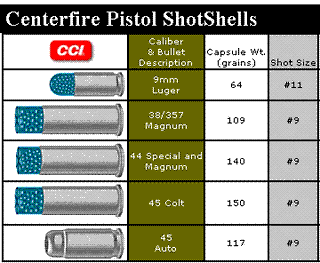
The .44 Magnum:
My plastic CCI box of .44 magnums probably
is ten years old, and the cartridges are loaded in conventional brass
cases rather than the current Blazer style aluminium cases now used. Headstamp
says "Speer." This box says "1/3 oz. #9 shot" and "approx 210 pellets."
Current advertising says the .44 contains 140 grains of shot which is
almost exactly one-third of an ounce. Three times 210 is 630 in an ounce.
I assume they are approximating as 9s should run 585 to the ounce.
I pulled apart one shell and found the shot to weigh
134 grains which rounds out to .31 oz., thus not far off the mark. The
pellet count was 163 which works out to 583 to the ounce, very nearly
exactly right for #9s. Shot. The two piece capsule weighed 13.6 grains
and the powder charge was five grains of a small grain flattened ball
powder, noticeably different from the powder used in the .45 ACP.
For my first shot at the pattern board at ten yards,
I used a nice old S&W Model 29 with a four inch barrel. This pattern also
spread over an area larger than the 28 x 36 inch pattern board. It contained
125 hits, so it was better than the .38/.357., but still was too much
spread and too thin a pattern for effective small game hunting at ten
yards.
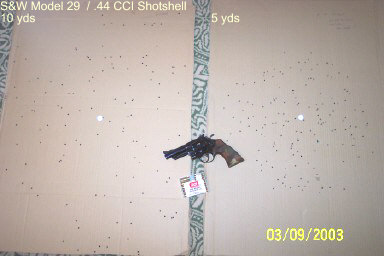 Rather
than complain that the 4 inch .44 "blew the pattern," I wondered whether
barrel length or something related to the cylinder-barrel gap affected
the outcome. I don't have another handgun in .44 magnum, but I do have
a nice old Ruger .44 magnum carbine. (Ever notice that I use "nice old"
to describe so much of my stuff?) This gun has an 18 inch barrel and,
of course, no cylinder-barrel gap. At ten yards, it shot a better pattern,
all apparently within 28 inches, but pellet count was only 135 suggesting
some still went around the board or through the holes made by pieces of
capsule. And, again, I judged it a bit too thin for reliably and humanely
dispatching small game. Rather
than complain that the 4 inch .44 "blew the pattern," I wondered whether
barrel length or something related to the cylinder-barrel gap affected
the outcome. I don't have another handgun in .44 magnum, but I do have
a nice old Ruger .44 magnum carbine. (Ever notice that I use "nice old"
to describe so much of my stuff?) This gun has an 18 inch barrel and,
of course, no cylinder-barrel gap. At ten yards, it shot a better pattern,
all apparently within 28 inches, but pellet count was only 135 suggesting
some still went around the board or through the holes made by pieces of
capsule. And, again, I judged it a bit too thin for reliably and humanely
dispatching small game.
I concluded that the rifled barrels were causing these
guns to spread at a faster rate than was desirable, at least for ten yard
shooting. Therefore, I tried the four inch Model 29 again, but at 5 yards.
Since I used the cartridge that I had disassembled for this shot, I knew
exactly how many pellets were in the load. The resulting pattern was absolutely
perfect 21 inch circle with very even pellet distribution. I counted 163
pellet holes, i.e., every one was there, plus two large holes where the
two pieces of the capsule also penetrated the board.*
This pattern was as good as one could want for small game.
Compared to the .45 ACP pattern (see below) at ten yards. The revolver
would be a better "brush load." Or snake load.
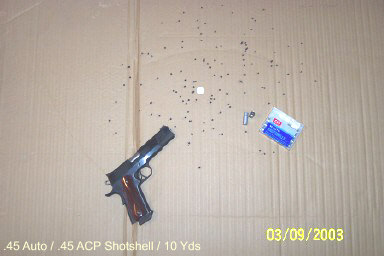 The
.45 ACP: The
.45 ACP:
My box of CCI .45 ACP shotshells also is probably ten
years old. It is marked the same as the .44 magnum, "1/3 oz. #9 shot"
and "approximately 210 pellets." The cartridge case is aluminium and, except
for length, is similar to the type CCI uses in its lower priced Blazer
line of ammunition. Incidentally, CCI uses a special Berdan pistol primer
in its aluminium cases to prevent them from being casually reloaded.
My ancient and honorable Ohaus balance scale said the
cartridge's gross weight was 180 grains. I used an impact (hammer-style)
bullet puller to get out the shot charge which weighed 127 grains, or
roughly .29 oz. The current advertising says it should weigh 117 grains
or .27 oz. I counted the pellets twice and both times counted 154. A charge
of .29 oz with 154 pellets translates into 530 pellets to the ounce. As
was the case with the .38/.357, these would be somewhat fat #9s. The powder
charge was 5.7 or 5.8 grains of a flattened ball powder.
The case contains no capsule but has a thick plastic
over-powder wad with no shot protector section. It is cupped deeply both
top and bottom and appears reversible. The case mouth is sealed by crimping
a thin and transparent but tough over shot wad corresponding to a "B-card."
One can clearly view the shot through the over shot card. The well rounded
crimp shape is designed to feed easily from magazine to chamber.
I fired one shot in my wife's nice old Colt Gold Cup.
The round cycled the action completely, reloaded the chamber, cocked the
hammer, and left the gun ready for a second shot. At ten yards, I got
a highly satisfactory pattern with approximately 150 holes in an area
measuring 17 inches high by 21 inches wide. The increased density of this
pattern compared to the .38/357 and .44 patterns suggests that the capsule
probably increases the effect of the rifling. Comparing the .45 auto pattern
with the revolver patterns leads me to conclude that the auto would make
a better small game load and the revolvers would make better "brush loads."
Incidentally, at the same time that CCI introduced its
.45 ACP shotshell, Remington also introduced one. Remington's version
used an extra long brass case with a pie crimped closure. Remington's
ads said it was loaded with approximately 650 #12 shot, the same size
used in .22 long rifle shot cartridges. Since number 12s run about 2475
pellets to the ounce, Remington 's payload weighed just over a quarter
ounce. The smaller shot might have quadrupled the number of hits on a
target and at close range probably would have been wonderful for chasing
rats around a corn crib. I believe it has been discontinued.
Before leaving the .45, two historical notes occur to
me. During WWII, the U.S. Army and Navy issued .45 ACP shot cartridges
for use in air crew survival kits. Prior to WWII, a special shot cartridge
was developed cartridge for the Thompson Sub Machine to be used for riot
control. Both cartridges used a paper shot capsule.
The .45 Colt:
I presently have neither a revolver chambered for the
.45 Colt (or Long Colt, if you prefer) nor any of the newly introduced
.45 Colt Shotshells. In fact, I did not know that CCI now offered .45
Colt shotshells until Web-meister Phil pointed out their existence. In
fact, I was surprised to see these cartridges advertised. About four years
ago, I talked at some length with one of CCI's gurus about shot cartridges
in general. One question I asked was why CCI had never offered a shot
cartridge for the .45 Colt. It seemed a natural to me, as it would hold
the most shot. The CCI gent said that he, too, had urged such a cartridge,
but the company refused to make one out of fear that someone might somehow
get one into an old black powder Colt and come to grief. As the shotshells
are loaded to pressures no higher than commercial lead bullet cartridges,
I cannot imagine such a cartridge damaging a black powder Colt, but I
never was a tort lawyer advising a big company. Looks like sense has prevailed,
and CCI now offers a .45 Colt loaded with 150 grains of shot, slightly
more than the 44. Magnum which is advertised as having 140 grains of shot.
However, Web-meister Phil suggested that, as the .410
can be used in the certain .45 Colt guns, notably the Thompson-Center
Contender and certain marvellous revolvers, then .45 Colt shotshells might
do for two inch loads in a .410. The answer is that they will not; the
.45 Colt case is noticeably larger in diameter than the .410 chamber.
The .410 works in the .45 Colt because its rim is big enough to be stopped
by the rear of the chamber and the .45 Colt bore is large enough for the
.410 shell to enter it, at least some bores are. When fired in a .45 Colt
chamber, the .410 case expands slightly to make up the difference.
I was curious about whether a .45 Colt might enter some
larger .410 chambers. I have some .45 Colt ammo and I and I tried to chamber
a round in both chambers of two .410 O/Us, both Italian, an old Rizzini-Zoli,
and a new Beretta. None of several brands of .45 Colt cases would fully
enter any of the four chambers. The aluminum CCI .45 ACP shotshell case
enters the chamber of my Remington 870, but not the .45 Colt. The .45
ACP is nominally only .004 thousandths smaller than the .45 Colt.
I also was curious about the .410's fit in the bore of
the .45 Colt. An inch or so of a .410 must enter the bore of a Thompson-Center
Contender .45/.410 barrel. Nominal specification show that the .410 should
be a very tight fit, if at all. I had no .45 Colt bore to attempt to squeeze
a .410 into, so I tried a factory .410 in a .45 auto bore. In fact, I
tried it in three of them. The groove diameter of the .45 Colt is significantly
larger than the groove diameter of the .45 ACP, or once was, but their
bore diameters are nearly the same. The factory new Winchester AA-type
.410 shell would not enter any of three different .45 autos' bores. This
makes me wonder whether the Thompson-Center .45-.410 barrel may have an
elongated chamber section or perhaps a very long and gradual leede. The
"leede," also spelled "lede: and "leade," is the conical section at the
front of a chamber where it transitions to rifling dimensions.
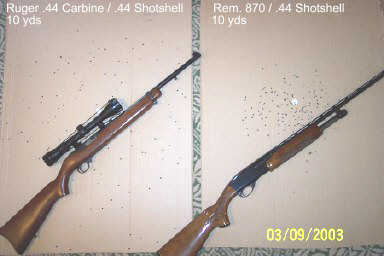 Effect
of rifling: Effect
of rifling:
I think rifled barrels spread my pattern more than a
smooth bore like the old Stevens or Marble's. (The Stevens also was available
with choke.) Rifling a shotgun barrel is a traditional way to make the
barrel spread more than a straight cylinder. Regrettably, I do not have
a smooth bore pistol to try any of these shells, but I do have a .410
shotgun. Neither the .45 Colt shotshell not the .45 ACP shotshell will
work in it, the .45 Colt is too big, while, as noted, the .45 ACP will
fit a .410 chamber, alas, it has no rim to hold it in place to await the
firing pin's blow.
Having got this far, I now point out that a .44 magnum
shotshell fits rather nicely in a .410 chamber. Remember all those .44/.410
chambers? In the interests of science, and without sanction of anybody,
not even me, I tried one .44 magnum shotshell in my ancient and honorable
Remington 870. (NEVER TRY THIS WITH A STANDARD .44 MAGNUM!)
Let me repeat, NEVER TRY THIS WITH A STANDARD .44 MAGNUM!
The standard .44 magnum cartridges with bullets are loaded to pressures
approximately three times as high as .410 proof pressures. In addition,
the .44 magnum bullet is approximately .430 inches in diameter. It will
freely travel approximately two inches before abruptly hitting a .410
barrel still backed by about 40,000 pounds of chamber pressure. Bad things
should be expected to happen. Very bad things. Don't do it.
With all that peroration out of the way, let me say that
the ten yard pattern warmed the very cockles of my shooting heart. It
measured a very round 15 inches across, caught every pellet in the case,
and was as near perfect as shotgun patterns get. I am sure that a choked
Stevens Off Hand shotgun would kill squirrels or grouse at 20 yards. That
is much farther than one could count on a .45 ACP could on to do it. These
were extremely useful guns for someone who had to shop for supper while
working in the great outdoors.
Special Notes:
On the early Thompson-Center Contender: I once had a
Thompson Center Contender with the early model light-weight barrel with
external choke device. A similar barrel was made in .357 magnum, but I
never saw one and presume they were not popular. Both barrels were designed
to shoot standard cases loaded with T-C's special HotShot shot capsules.
The .357 capsule held ½ oz of shot and was noticeably longer than the
.44 capsule which held 5/8 oz. of shot. T-C marketed both loaded ammunition
in 20 round boxes and shot-filled component capsules in 50 round boxes.
Shot sizes available in .44 were 6s, 7 1/2s, 8s, and 9s. I presume the
same sizes were available in .357.
I still have two boxes of the .44 capsules, one of 6s
and one of 7 1/2s. These cartridges loaded with HotShot capsules were
considerably longer than the CCI type and a shell loaded with one was
about two inches long, far too long for a .44 revolver chamber. Since
the barrel was rifled, something had to be done to stop the capsules spinning
before it got out of the barrel. The inside of the choke device contains
straight ribs which do that. I shot a few at Skeet targets and they worked
very well.
|

